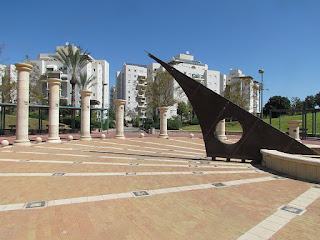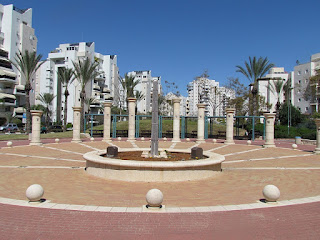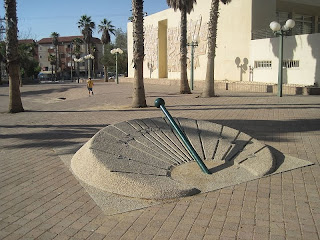Sundials were a very important mean in the past to measure and show the time. Today, sundials are regarded more as architectural and design artifacts. Most sundials contain a gnomon which is usually a rod which casts a shadow, and a table which shows the time. There are various types of sundials, simple and complex, and they can be very accurate. This article will show some examples of the many sundials that can be found around Israel.
For a tourist, one of the best places to look for sundials is the
Eretz Israel Museum in Tel-Aviv. The museum has a yard with replicas of ten sundials, old and new, from several places around Israel. Also, there is a planetarium in the museum which you should visit.
 |
| Sundial - Acre |
 |
| Sundial - Acre |
A replica of an ancient sundial
 |
| Ancient sundial - Israel |
The Curved sundial does not have a gnomon, the entire shape of the sundial is the gnomon and it casts a shadow on the curved area. Such a sundial is good only for half of the day, so there is a need for more than one (which is on the other side of the stone).
An interesting Sundial on Bat Galim beach in Haifa. Notice the different of the width between the hours in the scale.
 |
| Sundial - Haifa |
A replica of a Sundial from Jaffa.
 |
| Sundial - Jaffa |
An interesting mosaic Sundial in Kfar Masaryk (Near Acre)
 |
| Sundial - Kfar Masaryk |
On the western wall of the great synagogue in Petach-Tikva there are 3 sundials (All have replicas in Eretz Israel Museum). As they are on the west wall they can only be used in the second half of the day.
 |
| Sundial - Petach-Tikva synagogue |
 |
| Sundial - Petach-Tikva synagogue |
 |
| Sundial - Petach-Tikva synagogue |
העתקי השעונים נמצאים גם במוזיאון ארץ ישראל
 |
| Sundial - Petach-Tikva synagogue - Replica |
Also in Petach Tikva, in the Twelve Tribes park, a mosaic sundial.
 |
| Sundial - Petach Tikva - Twelve tribes park |
 |
| Sundial - Petach Tikva - Twelve Tribes park |
 |
| Sundial - Petach Tikva - Twelve Tribes park |
The largest sundial in Israel is in Rishon Lezion (Moshe Dayan street)
 |
| Sundial - Rishon Lezion |
 |
| Sundial - Rishon Lezion |
Going north again to Shomrat (Near Acre), an impressive sundial which has an "environmental" problem... The sundial is in the shade most of the day
 |
| Sundial in Shomrat |
A rather new type of sundial is the one without a gnomon at all. You are the gnomon and you need to stand along the middle line next to the relevant date (see the dates in the third photo). These sundials have become more and more common across the world. The sundial is in Eretz Israel Museum Tel Aviv
 |
| Sundial - Eretz Israel Museum Tel Aviv |
 |
| Sundial - Eretz Israel Museum Tel Aviv - When you stand on it, your shadow shows the time |
 |
| Sundial - Eretz Israel Museum Tel Aviv - Notice the various lines for the dates in the year. |
A most impressive park in Israel
Ramat Hanadiv, is in memory of Baron Rothschild and is located near Zichron Yaakov.
 |
| Sundial in Ramat Hanadiv Zichron Yaakov |
In Jerusalem there are several sundials. Here is one of them, the courtesy of
Yoav Avnion
 |
| Sundial on a synagouge wall, Jerusalem: Credit: Yoav Avnion |
And another famous sundial in Jerusaelm in Yafo street near Machena Yehuda market on the wall of Zoharey Chama synagouge.
 |
| Sundial on a synagogue wall, Jerusalem: Credit: Yoav Avnion |
 |
שעון שמש עם פסוק משיר השירים
בחצר בית הספר האנגליקני ברחוב הנביאים 82 בירושלים
בית הספר האנגליקני תוכנן על ידי האדריכל ברספורד פייט והוקם בשנת 1897
תמונת CC שצילם והעלה לפליקר רון אלמוג © |
A sundial near the public library in Yerucham.
 |
| Sundial in Yerucham - Sefi Shalev |
A very interesting sundial in the IDF officers academy near Mitzpe Ramon. The reflection of the dial rings is the hour,
 |
| Sundial in the IDF academy - Tom Rosenfeld |
My friend, Eden Orion - An astronomer and artist - Designed and built two sundials. The first sundial is in Kornit in the memory of Ben Sela.
You can read about Kornit's sundial here (In hebrew) and even if you can't read Hebrew you will see many more photos there.
 |
| Sundial in Kornit. Credit: Eden Orion |
Another sundial designed by Eden (Only the astronomical feature) and artistically designed and built by Yoav Shavit is in the national park of Ramat Gan.
You can see many more photos and diagrams here (Also in Hebrew but Google translate does a fair job)
| Sundial in Ramat-Gan. Credit: Eden Orion |
Back to Jerusalem and to a new sundial by the old city walls created by the artist Maty Grunberg. The physical design was done by Ilan Manulis
 |
| Sundial in Teddy Park, Jerusalem. Naomi Azar |
Yigal Zemer, an artist, designed and built many sundials in Israel. Here are some of his sundials.
 |
| Sundial in Beit-Shean's guest house, Yigal Zemer |
 |
| Sundial in Rechovot, Yigal Zemer |
 |
| Sundial in Mandelbaum pass, Jerusalem. Yigal Zemer |
 |
| Sundial in Raanana. Yigal Zemer |
A sundial can be part of a memorial monument like this sundial in Kedumim which is part of the memorial park to lt. Yishai Shechter.
| Sundial in Kedumim. Credit: Shlomi liss |
On the roof of Mitzpe Ramon visitor's center there is a very accurate sundials. The center is in memory of Ilan Ramon, the first Israel Astronaut who died in the Columbia disaster (PS: Ilan choose his last name to be Ramon because he liked the area, not vice-verse)
 |
| Sundial in Mitzpe Ramon. Anna Levin. |
 |
| Sundial in Mitzpe Ramon. Anna Levin. |
Sundials also symbolized the value of labor, and working in the files from sunrise to sunset. This sundial in Deganya (The first Kibbutz) represent this theme, The writing says: "The day is short and the labor is vast"
| Sundial in Deganya. Saar Nudel |
 |
| Sundial in Deganya. Saar Nudel |
A unique time-field in Givatiim. Each pole shows the correct time when the sun is aligned with it.
 |
| Sundial at Givataaim |
At the cave of the Patriacrhs in hebron there are old engravings which was used for sundial.
 |
| At the cave of the Patriarchs in Hebron. Photo: Amit Mendelson |
A special sundials' garden in Ashqelon by the artist Yigal Tomarkin.
 |
Sundials in Ashqelon: Photo: Avishay Taycher
|
A sundial with two gnomons (I am not sure which one is correct) is located in Tel-Azekah
 |
| Sundial in Tel-Azekah |
The following sundial is located in the Lido's beach Ashdod. At first, it seems as a regular clock, and at the time I was there it was cloudy.
 |
| sundial in Ashdod |
This sundial is at the summit of mount Tabor. Sadly as the clock is under shade it is not operational anymore, although you can see the subtle shade of the gnomon.
 |
| Sundial in Mt. Tabor - Photo by Muki zohar |
There are more sundials in Israel, large and small, old and new. I will try and add more from time to time.
Also look at the following sites for sundials all over the world, I will be happy to add more just comment or send me a note.















































